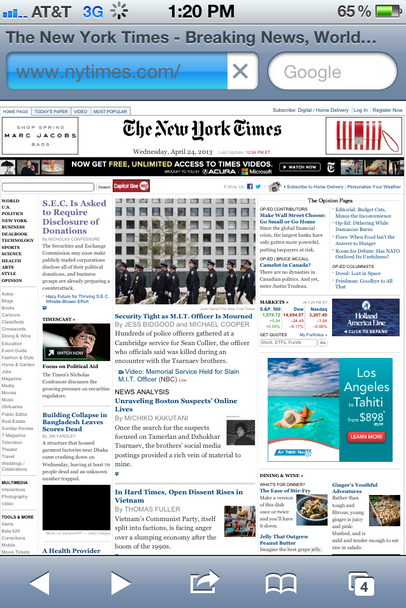
We hear ad nauseam that the future is mobile, and the future is now. And yet many publishers, which are seeing well over a quarter and up to 50 percent of their traffic from mobile, are still screwing up.
The problem is, for all the talk of “mobile first,” desktop remains the orienting principle of most publishers. (Digiday is an offender. We plan to address that with a forthcoming redesign.) Digiday spoke with designers at Code and Theory, Hard Candy Shell and Area 17 about five deadly sins when it comes to the mobile experience. Know of any other terrible mobile experiences? Leave them in the comments.
PORTING
Believe it or not, there are still some publisher sites that still port their desktop version over to the mobile Web. This is just bad form. The worst offender? The New York Times. Its redesign can’t come at a better time, as its mobile site is a carbon copy of the desktop, just tinier. This means you need a lot of patience to get through all the clutter — ads and stories — and it’s next to impossible to navigate.
“Consumers expect a site experience that is optimized for the device, both visually and in terms of functionality: swipe instead of click, scroll instead of paginate,” said Mike Treff, partner at Code and Theory.
PINCH AND ZOOM
This is a cardinal sin that will turn the average mild-mannered user-experience architect into a raging maniac. Publishers need to optimize their mobile sites so that font size is readable. Some sites don’t even let you zoom but instead keep the font size so small people need a magnifying glass to read. Sites like The New York Times, Entertainment Weekly and, yes, Digiday are all guilty of forcing readers to reverse-pinch their screens. Though according to Kemp Attwood, partner at Area 17, this has more to do with Apple than a publisher.
“Basically, [it says] we made a business decision to not create a mobile experience; just view through Apple technology,” Attwood said. “Apple’s done a great job making it accessible to read, and yet it was made for a desktop computer. It’s a poor user experience, a poor mobile user experience. It would not be anyone’s strategy.”
PAGINATION
Mobile is a behavior that is, by definition, fleeting. The success of apps like Twitter and Facebook at mobile is that they allow people to duck in and out. They’re perfect for killing time while waiting in line. Breaking stories into pages is a common problem. Sites as disparate as Business Insider and The New Yorker punish readers who want to look at a 47-page slide show or a 15-page article. Thankfully, each publisher gives a “view as single page” option. Sadly, it’s not the default.
“Pagination’s a horrible one, even more inexcusable on a phone,” said Kevin Kearney, CEO of Hard Candy Shell. “I generally see that going away. Even old-school media companies are getting away from that. Hopefully, we’ll be out of that hole in the next year or so.”
HOVER
On a desktop, people can scroll over images for more information. The problem with mobile is there isn’t a mouse. Many publishers fail to account for this, which Treff called “unacceptable.” StreetEasy, the New York City real estate site, offers visitors full pictures on profiles of apartments. No such luck with mobile.
“Hover events should be disabled on mobile,” said Kearney. “You can’t put key info into a hover state these days if it’s necessary information people need to access on a tablet on a phone.”
LOAD TIME
Publishers need to realize that phones have a slower connection than desktops. Image-sizing gunks up the works. Treff points out that image sizes should be optimized to load not only to device but also to the connection speed on the device.
“There’s a slower connection on the phone, and publishers need to be cognizant of how page loads will interact with the understanding of the experience and if it’s worth waiting for it,” Kearney said. Anything that’s trying to do heavy-handed scripting is challenging on a mobile phone.”
More in Media

NewFronts Briefing: Samsung, Condé Nast, Roku focus presentations on new ad formats and category-specific inventory
Day two of IAB’s NewFronts featured presentations from Samsung, Condé Nast and Roku, highlighting new partnerships, ad formats and inventory, as well as new AI capabilities.

The Athletic to raise ad prices as it paces to hit 3 million newsletter subscribers
The New York Times’ sports site The Athletic is about to hit 3 million total newsletter subscribers. It plans to raise ad prices as as a result of this nearly 20% year over year increase.

NewFronts Briefing: Google, Vizio and news publishers pitch marketers with new ad offerings and range of content categories
Day one of the 2024 IAB NewFronts featured presentations from Google and Vizio, as well as a spotlight on news publishers.
Ad position: web_bfu
